Beer boom
Grand Valley alums help drive craft beer resurgence
photos by Elizabeth Lienau video by Jeremy Knickerbocker
Craft beer, and the industry behind it, is in the midst of a revival that’s been more than 100 years in the making, and West Michigan is becoming a national power in the quickly growing culture.
The growth of the craft beer industry over the past decade has been staggering. In Michigan, the number of breweries in operation has jumped from 73 in 2004, to more than 150 today.
Nationally, a boom is underway as well. From a low of just 44 breweries in 1979, the industry has exploded to 2,751 breweries in operation in 2012. The last time that many breweries were in operation in the United States, the union only had 38 states and Grover Cleveland was president — it was 1887.
The craft beer industry is a growing market. According to the National Brewers Association, the craft beer industry produces about 8 percent of the nation’s beer and takes in about 14 percent of the nation’s $100 billion dollar beer budget.
In Michigan, beer money has a significant impact on the economy. Data from the Michigan Brewers Guild indicates that in 2014, 65 percent of all craft beer sold in the state was produced in Michigan, and the economic impact of the industry in 2014 was $608.9 million dollars, and created 7,100 jobs.
Many Grand Valley alumni are involved in the West Michigan beer scene, either in ownership and management roles, or physically involved in the brewing itself. In many cases, they do both. The beer culture isn’t limited to brewpubs and bars. Dave Huizen, an assistant professor in Grand Valley’s occupational safety and health program and homebrewer, is designing a brewery safety program that’s getting national attention.
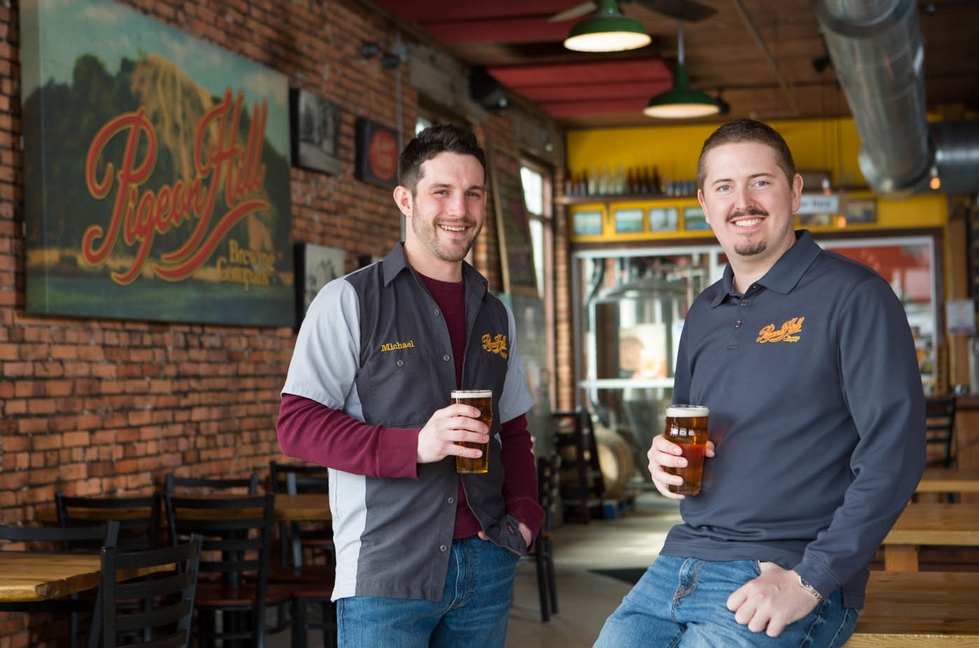
photo by Elizabeth Lienau
Michael Brower, left, and Joel Kamp enjoy a pint at Pigeon Hill, their brewery in Muskegon.
Big passion for art of brewing
Alumni are involved in brewing operations ranging from large microbreweries with multi-state distribution to small, niche facilities focusing on a very specific product. But a common thread regardless of size is a big passion for the craft and the culture that goes along with it.
Jason Spaulding, ’95, of Brewery Vivant, said the most satisfying part of running his brewery, which specializes in Belgian-style beers, is getting someone who claims they don’t like beer to try a glass of his and seeing their reaction.
“Most of the people who say they aren’t beer drinkers haven’t had something as unique as what we make. They’ve only had the beers put out by the huge American breweries. This is completely different,” Spaulding said. “I love watching people’s first time trying beers with real character.”
Spaulding has been involved in the West Michigan craft beer culture since 1997, when he helped open New Holland Brewing Co. just two years after graduating with a degree in health sciences. He said his time at Grand Valley helped him learn who he was and really figure out what he wanted to do while providing a solid background in science that he applies to brewing. “But I may have pursued academics a little less than I pursued beer,” he joked.
Spaulding left New Holland in 2005 and opened Brewery Vivant with his wife, Kris, ’06, in 2010. “We noticed that in California and Colorado the craft beer industry was taking off, and it was a bit absent in Michigan, so we saw an opportunity,” Spaulding said. “At first we had to explain the basics of beer to people, like what made ours different from what they’d been drinking their whole lives. Now demand has skyrocketed, and we’re thrilled with where we are.”
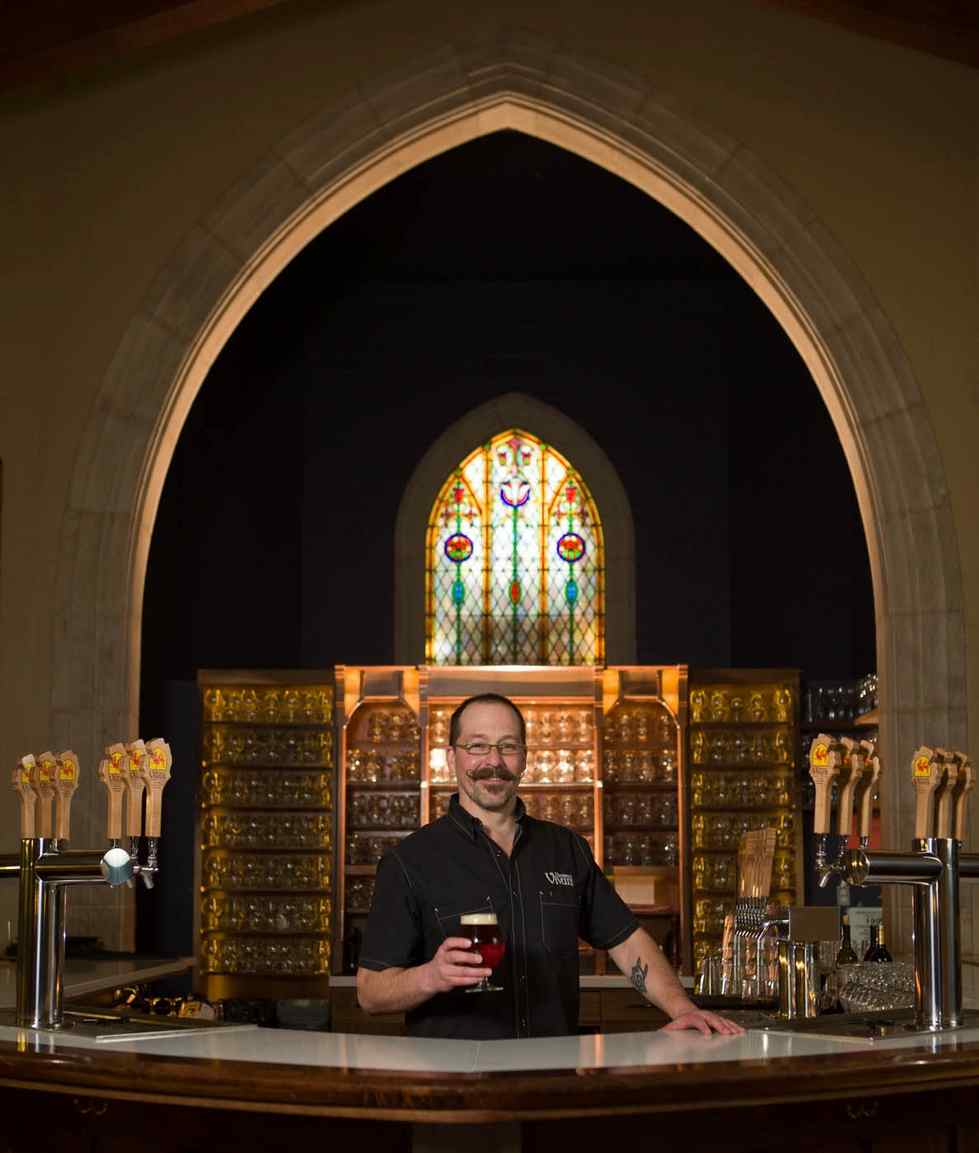
photo by Elizabeth Lienau
Jason Spaulding holds a tulip glass of his Belgian-style beer at Brewery Vivant, in Grand Rapids.
Michael Brower, ’07, and Joel Kamp, ’06, are two of the three owners of Pigeon Hill Brewing Company in downtown Muskegon. Brower majored in psychology and philosophy before studying law and becoming a liquor lawyer, and Kamp majored in accounting and finance. Brower handles the brewery’s legal requirements while Kamp manages the business side.
“My family has been in the alcohol industry for years, and I knew since I was a kid that I wanted to open a bar, I just never knew I wanted to do craft beer until I was exposed to it,” Brower said. “I was drawn to the industry because of my family legacy, and jumped at the chance to be part of the craft beer movement.”
Brower’s passion for the craft side of the beer industry came when a client invited him to brew a batch at his house. That led to exploration of the craft beer scene and an epiphany. “I went in to HopCat (a Grand Rapids brewpub) and saw hundreds of beers on tap, all different and all something I realized someone was very proud of,” Brower said. “Now we operate our own brewery, and we’re lucky enough to do what we love, and do it well. There’s something satisfying and beautiful about creating a product with your hands. It’s an art.”
The passion for craft brewing doesn’t stop with beer. Jason Lummen, ’05, owner of The People’s Cider Company in Grand Rapids, produces ciders from local apples and is excited about producing a unique product that challenges people’s palates.
“I’d never experienced ciders until I went to study abroad through Grand Valley in the United Kingdom, and I got a job bartending,” Lummen said. “Over there, ciders aren’t like the Woodchuck you get in stores here, it’s a much drier product, and far less sweet. I realized when I got back that I was passionate about making it and realized it was what I wanted to do. I spent a few years in an office job and realized it wasn’t for me. I decided to run with my passion for cider.”
Lummen said he loves the hands-on artistry that goes into producing each batch, from the sourcing of the apples from Kent County’s Fruit Ridge (Lummen: “It’s like Napa Valley but for apples.”) to selecting used bourbon barrels for aging each of the batches he makes.
Keeping it local
Another common thread among craft brewers is a distinct sense of community and cooperation. Grand Valley alumna Laura Gentry, ’13, who owns and operates Tripelroot in Zeeland with her husband, Nate, said running a local brewpub in a small town has been a rewarding experience.
“We have lived in Zeeland for the past 10 years, and we took an old space in downtown Zeeland from the 1800s and completely rehabbed it from the ground up,” Gentry said. “We wanted to stay in Zeeland because we love the neighborhood feel.”
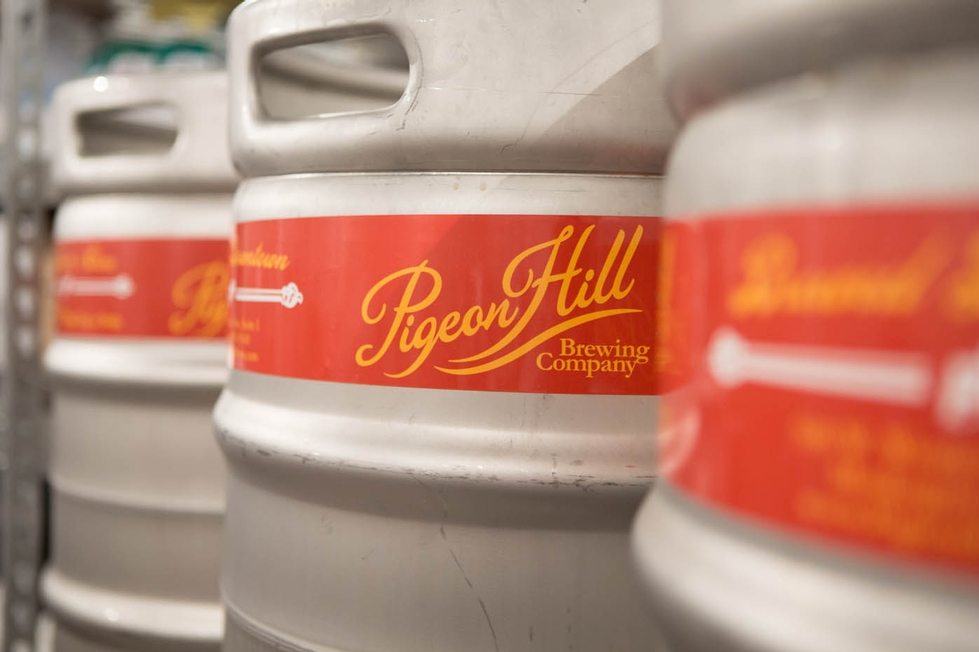
Kegs at Pigeon Hill, a brewery in downtown Muskegon.
Spaulding said the renaissance of the craft beer industry harkens back to the days when each neighborhood would have its own unique service providers. “Every town would have a local baker, a butcher, a hardware store and a pub,” Spaulding said. “There’s room for more growth in this industry. People like to support local businesses and take part in a business that’s focused on their community. Everywhere breweries are opening in West Michigan, there is a neighborhood demand. People want to be able to go down the street and get a pint from a local place they like.”
Brower, from Pigeon Hill, said community ties are what led him to open a brewery in Muskegon instead of closer to Grand Rapids, the epicenter of the West Michigan craft beer scene. He even named the brewery after a hill a few miles away, near where he grew up.
“When we said we were opening a brewery in downtown Muskegon, people told us we were crazy,” Brower said. “But now that the doors have opened, people flock here. It’s a wonderful community and people are excited to support a revitalization of the city.”
Kamp, also a Muskegon native and Brower’s co-owner at Pigeon Hill said they made it a point to use Muskegon’s history while decorating the brewery’s tap room, which is managed by Brower’s wife, Alana, ’08, a Grand Valley alumna. “We wanted to use the community history to build pride in our operation. We are proud of where we’re from, and proud of what we’re doing,” Kamp said. “We want a city that’s had some tough times to get a boost from us being here.”
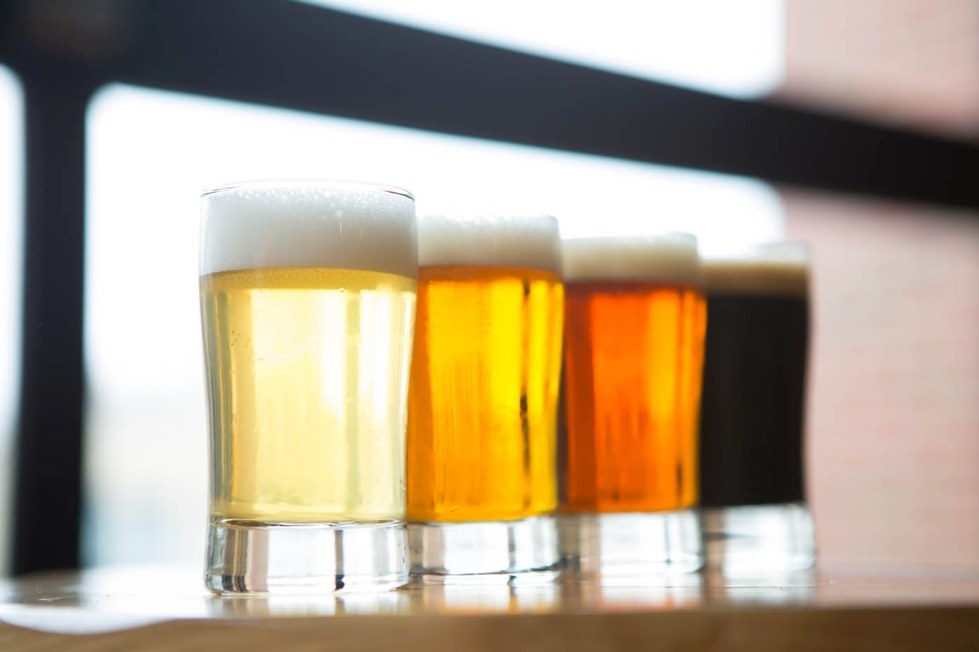
Flight of beer from Brewery Vivant.
Consumers and trends
Spaulding said the sophistication of consumers in West Michigan has increased over the past decade as the craft beer movement has progressed. Consumers are more willing to try beers that are unique and different, he said, which allows brewers to be more artistic and adventurous with what they brew.
“Twenty years ago, a brewery like ours that focused only on Belgian styles wouldn’t have been able to make it, because no one was familiar with the style, it would have been too risky,” Spaulding said. “The fact that we can focus on such a niche style and be successful says a lot about how far the craft fans in West Michigan have come.”
The brewers at Pigeon Hill are also relying on adventurous consumers, and being rewarded for their creativity. They brew an ale they affectionately call “O.C.P.” which stands for Oatmeal Creme Pie, a beer that tastes exactly as the name implies that was inspired by Kamp’s wife (a key ingredient is marshmallow fluff, but the recipe is secret, Kamp said). Another unique concoction is a Thai chili and lemongrass beer they served at the Michigan Brewer’s Guild Winter Beer Festival.
“You have to make sure your product matches what the consumer’s palate is expecting, but you also have to brew what you like to drink,” Kamp said.
Tripelroot’s Gentry, who makes a black IPA called Mulletude, said that craft beer fans aren’t necessarily brewery-specific, they like to try lots of different styles from different places, which means possibilities for growth and continued innovation are wide open.
“Who knows what will happen in 10 or 15 years,” she said. “The craft beer drinker isn’t sticking with one bottle like some macro-beer drinkers. They like craft, they like the culture and the scene overall. They’re going to want to keep trying new stuff.”
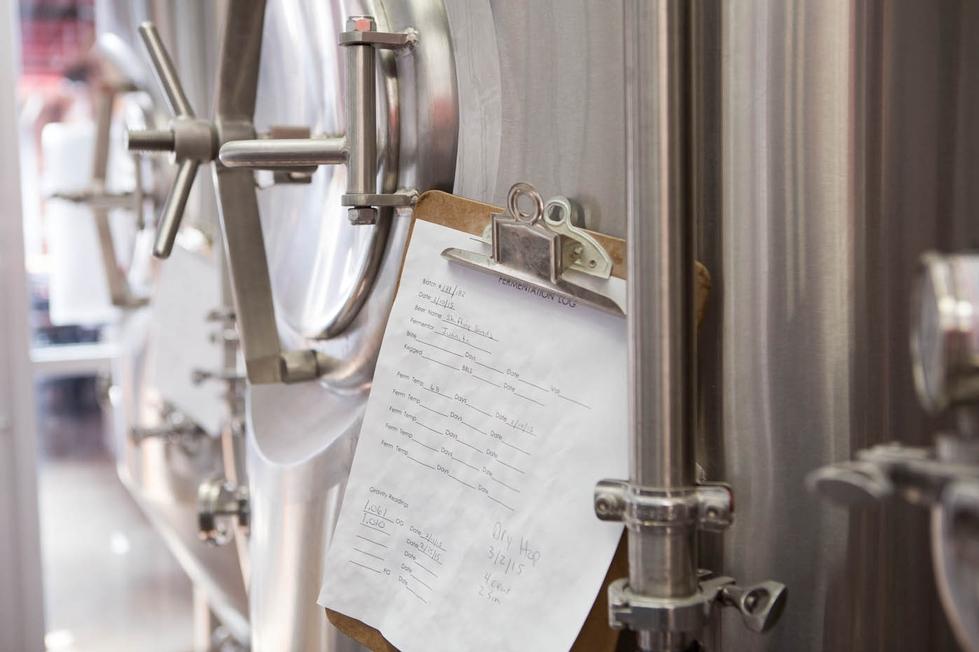
A beer vat at Pigeon Hill is pictured.
Beer in academia
The craft beer industry is also providing opportunities for growth in other markets — including academia. Dave Huizen, assistant professor of occupational safety and health, is using the boom to launch a brand-new safety training program aimed strictly at brewers.
Huizen has worked with local brewers, including Spaulding, to produce a series of safety and health training videos and programs specifically related to the brewing industry. His work, supported by $75,000 in MI-OSHA grants, is getting attention for being the first safety training series of its kind in the nation.
“The rapid growth of the craft beer industry in West Michigan means that there has been a huge increase in the number of microbreweries that are often only running with a few employees, which can make the brewing process more dangerous,” Huizen said. “We saw that most of these brewers were fiercely passionate about their product, but didn’t often know all the ways to help keep themselves and their employees safe.”
Huizen said some of the dangers in a working brewery include harsh acids and chemicals that brewers must use to sanitize and clean equipment and kegs, confined spaces inside vessels used for mashing and fermentation, and basic ergonomics when it comes to lifting heavy bags of grain, empty kegs, or boxes of bottles. Huizen, an active homebrewer for 24 years who said his wife would describe him as a “beer snob,” said he saw an opportunity to create a unique program for brewers while creating opportunities for students to get hands-on experience in safety roles.
Several students are currently safety interns at area breweries. The online training program called “Safe Zymurgy” (zymurgy is the science of fermentation, usually related to brewing and winemaking) is free to brewers and creates chances for students from several disciplines to get real-world experience building a training program.
“We had students from computer information systems help us build the online training site, and had film and video students helping us creating the videos for the modules,” Huizen said. “It was a great way to get students from different disciplines to work together to create a unique and useful program.”
Huizen said the demand for the program is out there, evidenced by the roughly 100 brewers so far who have completed the safety course. “The brewers wanted it, but until we put it together, nothing like this existed,” Huizen said.
Beer terms
ALCOHOL BY VOLUME (ABV): The amount of alcohol in a beer, described as the percentage volume of alcohol compared to the volume of beer.
BARREL: A measure of capacity used by brewers. In the United States, one barrel holds 31 U.S. gallons. A keg is a half barrel, or 15.5 gallons. A 7.75 gallon keg is often referred to as a “pony keg.”
BITTERNESS: The amount of the bitter flavor an individual beer has. Traditionally measured in IBUs, or International Bitterness Units.
DRY-HOPPING: Adding dry hops to beer while it’s being fermented or aged to increase aroma, flavor and taste.
FERMENTATION: Conversion of sugars by yeast into ethyl alcohol and carbon dioxide.
LAGER: A lager is a beer produced by bottom-fermenting yeast with fermentation temperatures that are much lower than ales.
